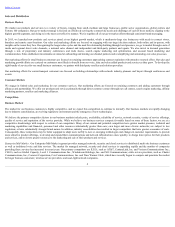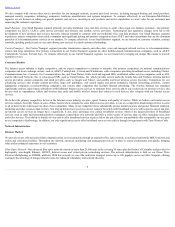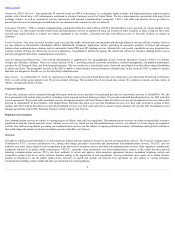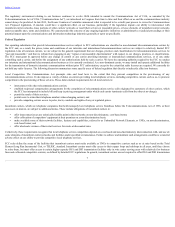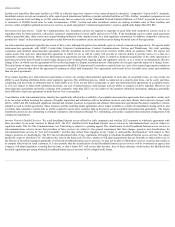Earthlink 2015 Annual Report Download - page 17
Download and view the complete annual report
Please find page 17 of the 2015 Earthlink annual report below. You can navigate through the pages in the report by either clicking on the pages listed below, or by using the keyword search tool below to find specific information within the annual report.
Table of Contents
Item 1A. Risk Factors.
The following risk factors and other information included in this Annual Report on Form 10-K should be carefully considered. The risks and uncertainties
described below are not the only ones we face. Additional risks and uncertainties not presently known to us or that we currently deem immaterial also may
adversely impact our business operations. If any of the following risks occur, our business, financial condition, operating results and cash flows could be materially
adversely affected.
Risks Related to Our Strategy
We may not be able to execute our strategy to successfully transition to a leading managed network, security and cloud services provider, which could adversely
affect our results of operations and cash flows.
Our business strategy is to be a leading managed network, security and cloud services provider for multi-location retail and service businesses. We have taken
several steps over the past two years to execute this transformation, including aligning our organization and operating model around four customer categories and
decreasing investments in our traditional voice and data products for small business customers to focus on managed network, security and cloud services to larger
multi-location businesses. There can be no assurance that our strategy will be successful. The market for managed network, security and cloud services is still
relatively new and continues to evolve. If we do not have sufficient customer demand to support our new services, our financial results may be harmed. Our
success depends on the timing and market acceptance of our new products and services, our ability to market our services in a cost-effective manner to new
customers, our ability to differentiate our services from those of our competitors, our ability to maintain and expand our sales to existing customers, our ability to
strengthen awareness of our brand, our ability to hire and train effective personnel, our ability to provide quality implementation and customer support for these
products and the reliability and quality of our services. If the market for these services fails to grow or grows more slowly than we currently anticipate, or if our
services fail to achieve widespread customer acceptance, our business would suffer. Any of the foregoing could adversely affect our results of operations and cash
flows.
We may not be able to increase revenues from our growth products and services to offset declining revenues from our traditional products and services, which
could adversely affect our results of operations and cash flows.
Revenues from our traditional products and services, which include traditional voice and data services for business customers and Internet access services for
residential customers, have been declining due to competitive, technological and regulatory developments and we expect these revenues to continue to decline. In
addition, we narrowed our product portfolio to provide a more focused suite of services and discontinued sales of certain non-strategic products, including the sale
of certain assets associated with our IT services product offerings in February 2016, which increases our revenue decline. To offset our revenue declines, we are
focused on continuing to develop our growth products and services; increasing revenues from these products and services; improving the efficiency of our internal
processes for offering and delivering our growth products and services; and staying ahead of technology advances such that we are offering competitive and
technology relevant products and services. Our growth products and services include MPLS, hosted voice, hybrid WAN and managed network, security and cloud
services for multi-location businesses and transport services for wholesale businesses. We may not be successful in our efforts to increase revenues generated from
our growth products and services to offset the revenue declines in our traditional products and services. In addition, the sales cycle for our growth products is
longer than the sales cycle for our traditional voice and data products, especially as we compete for larger and more complex customers and we have experienced
process and system delays related to customer installations. If we are unable to increase sales of our growth products and services to counteract these declining
revenues, if we are unable to manage churn, if revenue growth takes longer than expected, if we do not improve the efficiency of our processes or if we do not offer
competitive products and services, it could adversely affect our results of operations and cash flows.
If we are unable to adapt to changes in technology and customer demands, we may not remain competitive, and our revenues and operating results could
suffer.
We operate in an industry characterized by changing technology, changes in customer needs and frequent new service and product introductions. Our shift in
strategy to become a leading managed network, security and cloud services provider increases our exposure to the impact of changes in technology, such as the
adoption of cloud computing and Software-as-a-Service, and changes in customer demands, such as the increased demand for data and the increased use of
outsourcing. Further changes in technology, such as SD-WAN and other emerging technologies, could also impact our competitiveness in market for managed
network services. In addition, changing technology and consumer behavior (such as wireless displacement of wireline use and increasing use of VoIP) impacts
demand for our traditional voice and data products. Our success will depend, in part, on our ability to use leading technologies effectively, to continue to develop
our technical expertise, to enhance our existing services and to develop new services that meet changing customer needs on a timely and cost-effective basis. We
may not be able to adapt quickly enough to changing technology, customer requirements and industry standards. If the technology choices we make prove to be
incorrect,
14


